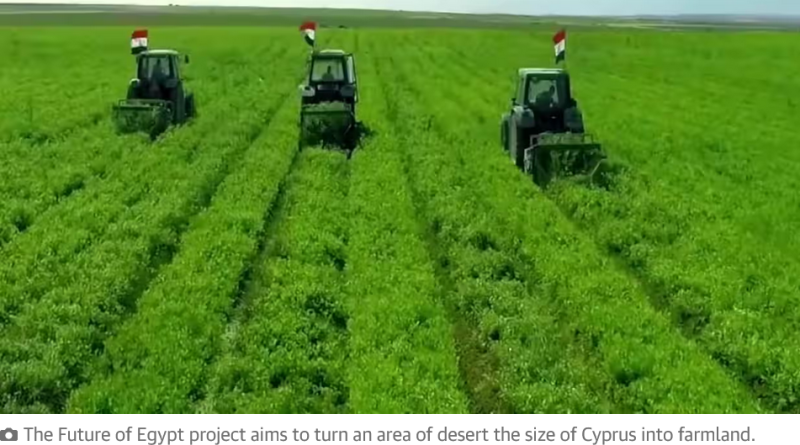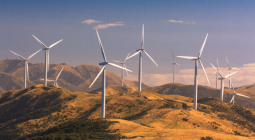Greening the desert: is Sisi’s grand plan using up all of Egypt’s water?

For the two hours drivers can spend on the eight-lane, often empty, highway from Cairo to El Dabaa on the north coast, all there is to see is miles and miles of intensively farmed land on each side. Ten years ago, this expanse of the Western desert was little more than rocks and sand.
It is the first stage of the vast Future of Egypt project, which will eventually encompass 2.2m feddans (9,240 sq km, or 3,500 sq miles) – an area the size of Cyprus.
“The map of the Egyptian desert is changing colour,” declared a recent promotional video, “from yellow to green”.
Satellite images of the area show hundreds of fields with centre-pivot irrigation (in which sprinklers rotate over the crops), some up to a kilometre in diameter. An artificial river 70 miles (114km) long is nearing completion at a cost of more than $5bn (£3.9bn). Once completed, it will carry 3.5bn cubic metres of water a year to the fields.
This multibillion-dollar megaproject accounts for just over half of the Egyptian government’s plan to turn 16,800 sq km of desert into farmland before 2027. President Abdel Fattah al-Sisi announced this ambitious project shortly after coming to power in 2014 in a military coup.
Speaking at the Future of Egypt’s inauguration in May, he reaffirmed his desire to see the desert bloom, saying: “If we had enough water to cultivate 100m feddans, we would do it.”
Yet Egypt is already suffering from an annual water deficit of 7bn cubic metres, according to the UN. It is also dealing with austerity cuts to address a debt-to-GDP ratio of more than 90% that has ballooned under the Sisi administration, largely due to its lavish spending on infrastructure megaprojects and new equipment for the armed forces.
Critics of expensive land-reclamation schemes question the cost to the public purse and the ecosystem of military-led agriculture projects that have boosted exports but have done little to prevent massive food-price inflation, which in April, was the fifth-highest in the world.
“They call it reclamation. It’s not reclaiming,” says Richard Tutwiler, a former director of the Cairo-based Research Institute for a Sustainable Environment. “It’s not like it used to be this way and now we’ve got to make it back this way.”
Unlike the rich soils of the Nile valley, watered and fertilised through millennia of floods and irrigation, the sands of the Western desert have long been arid, with few nutrients for crops. They require vast amounts of irrigation to become fertile – water that is impossible to recover.
On the banks of the Nile, farmers are estimated to use the same water seven times between Upper Egypt and the Mediterranean, with the runoff from fields draining back into the river or into underground aquifers to be reused farther downstream. In the desert, water “just goes back into the desert”, says Tutwiler.
Most of the water to irrigate the new fields comes from groundwater reserves. For centuries, farmers in oases across the desert depended on this water, which flows naturally to the surface at points. The Sisi administration has increased efforts to industrialise consumption of groundwater, investing in numerous pumping stations across the desert to draw it up to the surface
“You have huge amounts of water under the Western desert but it’s limited,” says Tutwiler. A study from last year examining satellite images that revealed Egypt’s groundwater resources found that the rate of depletion of water under the Western desert has already doubled since Sisi took office.
“What about future generations?” says Tutwiler. “If you use up all the water, they won’t have water in the desert.”
Growing use of wells does not just lower groundwater levels, but also increases its salinity. According to Saker El Nour, an agrarian sociologist, numerous desert agriculture projects are already suffering from salination, driving down production from the fields and pushing up the costs of farming.
With just three years to go until 2027, the government has achieved just 20% of its reclamation target: 3,400 sq km, according to recent announcements.
El Nour believes that even this is “an exaggeration” and that the true amount of land could be much smaller and far less profitable than the government has suggested. “Just because there’s a huge ‘greening of the desert’, it doesn’t mean that there’s a huge product coming out of this,” says El Nour.
Sherif Fayyad, an agricultural expert who has advised the government, worries that the project is at risk of becoming a publicity stunt. “They just want to say to people, ‘Hey, we reclaimed 4m feddans,’” he says. There are no publicly available figures on the production of the reclaimed lands, but Fayyad doubts that much has yet been harvested.
“The productivity and the fertility of the soil itself will never reach the fertility and productivity of the old lands [by the Nile],” he says, explaining that many of the staple crops on which Egyptians rely, including wheat and legumes, are unsuited to this new land.
“For this reason, the poor and lower-middle class don’t feel that this kind of reclamation project benefits them,” he says.
Since March 2022, food prices in Egypt have soared. Last October, Egyptian real food inflation was the highest in the world, according to the World Bank. As one of the world’s largest wheat importers, Egypt was severely hit by the supply-chain shocks caused by the Covid pandemic and the war in Ukraine.
But during that same period, Egypt’s food exports also rose from 5.6m tonnes in 2021 to 6.4m tonnes in 2022, reaching a record 7.5m tonnes in 2023. Much of the increase came from relatively high-value crops such as fruit and nuts.
Sisi has defended using reclaimed land to grow cash crops for export. “I can grow a million feddans of wheat”, he said at the inauguration in May, “while there are other crops you can produce that are worth three times more.” He claimed the strategy was a crucial move to narrow the trade deficit and find new sources of foreign currency.
Fayyad says of the Future of Egypt scheme: “It is important. But people don’t feel that these projects are for them because they don’t see the result in the prices for their food.”
While nearly half of the crops grown in Egypt are produced by smallholders, state-backed reclamation projects are dominated by the armed forces. The military controls a vast swathe of the economy, from factories to farmland, using its privileged position in the country to edge out competitors.
There are credible reports that the army regularly uses military conscripts to work in the fields. Relevant government ministries did not respond to multiple requests to comment for this story.
The Future of Egypt project, led by Bahaa al-Ghanam, an air force colonel, has released no financial records. Aside from piecemeal press announcements, there is no publicly available information on how much it spends, how much it will earn or how it will divide profits.
In recent months, the government has imposed austerity measures elsewhere, increasing the cost of fuel and tripling the price of subsidised bread in an effort to bring down the nation’s growing debt obligations.
Despite promising to scale back spending on expensive projects – under pressure from the International Monetary Fund and regional allies – Sisi said in May that the government would spend a further 190bn Egyptian pounds (£3bn) in the coming years on new infrastructure to support his agricultural ambitions.
“It’s serious, serious money,” says David Sims, an urban planner and author of Egypt’s Desert Dreams, which examines past government schemes in the country. “Somebody is going to have to pay for all this.”





